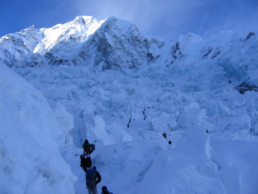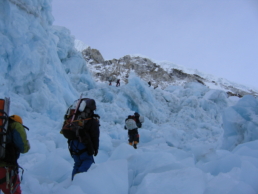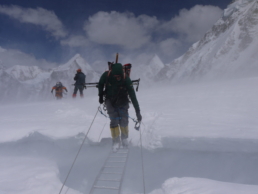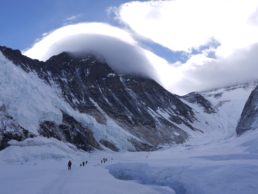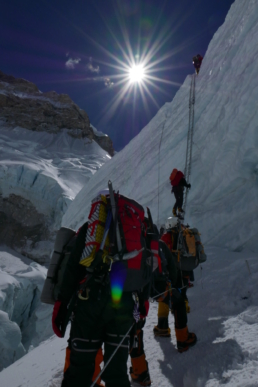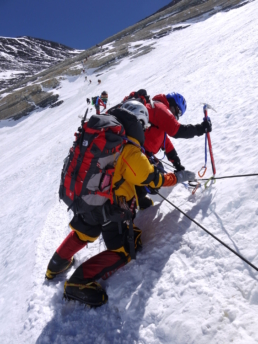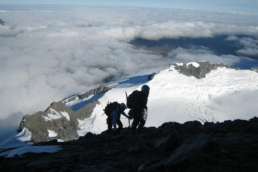Fixing Everest
The Southwest Ridge of Mt Everest at dawn, as seen from Lhotse
By Guy Cotter, CEO of Adventure Consultants
I’d say most of us recognise that there are issues on Everest.
Accidents, overcrowding, a lack of cohesiveness each season with rope fixing when teams who say they will help and don’t turn up, Icefall charges much higher than the quality of work that is completed, inexperienced climbers, teams who provide no support when their team members get sick or have an accident.
So what do we do? As a group of people it is in our best interest to sort this out – and it isn’t that hard. However it will take some resolve and some changes to achieve and we will need to establish some standards.
Safety should always be the highest priority. Over the years the quality of the ropes and the fixing on the upper mountain has improved dramatically. We are seeing less instances of a 200m coil of Korean rope with only one or two anchors that results in 60 to 100 people hanging on a rope that has a breaking rate of around 400kg!
Safety in the icefall will always be a concern.
However it is a credit to the icefall doctors that the route in 2015 survived the 7.8 earthquake. We can also credit the assistance of David Breashears that year for helping the icefall doctors to keep the route to the centre of the glacier below Camp 1. This must be continued and we need to continue to avoid the icecliffs on the north side of the icefall as we used to before 2006.
The icefall needs to be opened earlier in the season to spread people out when it comes to summit time. Many of the problems on the mountain come from the icefall being opened late, thereby forcing everyone to summit at the same time. In the 90’s, when we opened the icefall at the 1st of April, people could summit from May 1 onwards. This needs to be reinstituted and the SPCC needs to recognise the responsibility they have on this mountain and act accordingly or else give the responsibility to an entity that will achieve this. While they are at it they should also ensure there are always two ropes in difficult sections and not grudgingly improve the route when enough teams come to complain. Doing this properly should be a matter of pride of a job well done to a high degree. My feeling is that this can only be done by a mountaineer, or group of mountaineers, who take pride in doing the job well with sufficient resources given to that group to do the best job they can. A significant component of the reputation of Nepal rests in the hands of the SPCC, and it should be treated with that gravity of deference.
Continuing with the discussion of safety in regards to the icefall, I still firmly believe that we should be given permission to have helicopter assistance to move loads to Camp 1 at the start of every season, where every team can get their loads carried by longline over the icefall, thereby removing the need for so many loads to be ferried by Nepalese mountain workers throughout the season. Then at the end of the season the loads are ferried back down. I do not propose that this happens throughout the season as none of us wants to see a proliferation of helicopters overhead each day we climb. And just to be very clear, I do not think that people can claim an ascent of the mountain if they have been ferried to Camp 1 by helicopter and would never want to see this. My purpose here is about lowering the exposure to hazard to locals in the icefall.
Let’s also train people to not fall into crevasses in the Western Cwm. Early season it is especially dangerous to walk un-roped up the Cwm to Camp 2. This is basic mountaineering and we should not be having accidents here any longer.
Let’s coordinate rope fixing up high better.
I would suggest that the group who fix the icefall also fix to the summit, but it seems that in Nepal that if one group gets the power to dominate a situation they use this to their own advantage. I have to congratulate the SPCC for being quite reasonable in this respect so perhaps they should fix the entire mountain, but the executive of the organisation should include a cross section of the users (eg. local and western operators) without stacking the board to one side to meet the desires of one group.
All operators should maintain standards for client pre requisites for joining their teams. Local operators are getting clients by offering the lowest pricing. We all know that this can best be achieved by cutting corners and that directly affects safety. Offering really cheap expeditions to experienced climbers who need little assistance and are self-contained is fine, if climbers are of the calibre of Reinhold Messner we wouldn’t need to force him to have a high level of support. But all the time now we see clients with absolutely no experience who have joined a particular team because it is the cheapest and that shows their ignorance and the ruthlessness of the operator to accept them without them having the ability to avoid having accidents.
Large teams with low ratios of qualified guides/Sherpas are another major issue that generates crowding and affects safety when things go wrong. If a client needs support, and there is no guide/Sherpa there with the means to help, then that team has been poorly resourced and should not be allowed to operate in that manner. All staff who are directly supervising/guiding the clients, be they from the west or local, should have appropriate medical and rescue training. There should be no acceptance of non-qualified staff on the mountain because they are cheaper. Just like clients, mountain workers should also prove their preparedness to be on that mountain.
Every operator should be transparent about what type of expedition they operate, whether it be guided, professionally led, services only, and so on. Members on those expeditions should have to prove they are appropriately qualified for that specific style of expedition.
Human waste also needs to be addressed. The best way I can think of to do this is to institute a program like they have on Denali where people must remove their own waste from the mountain. A receptacle should be placed at Camp 1 for bagged human waste, and this could be flown off by helicopter at the end of the season for disposal. Any foreigner who is appropriately experienced coming to Everest, should have been to a place such as Denali or Vinson Massif where they have done this before, so there is no reason that it cannot be done in Nepal.
To summarise
The reputation of Everest has been tainted and that impacts on all of us who operate there. If we do not collaborate and make real effort to make positive change, the problems will intensify and the crown jewel will be lost, as will the attraction of mountaineering in general. My fear is that if we, the people who have a vested interest in Mt Everest, do not sort out the issues ourselves, the government will be forced to step in to regulate activities on the mountain and the mountain does not deserve that.
I know the mechanism of establishing cohesive collaboration is not easy to achieve in a situation like this. I would be concerned that if we all came together to discuss these issues on an equal footing that we would fail to achieve a consensus. I would like to see the SPCC take leadership on this and propose a pathway towards responsible stewardship on Mt Everest.
Related Posts
November 9, 2016
Return to Tititea
November 3, 2016

